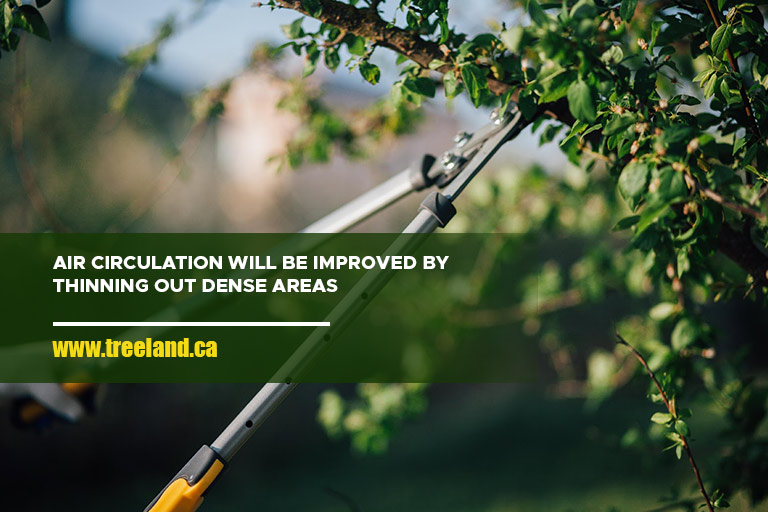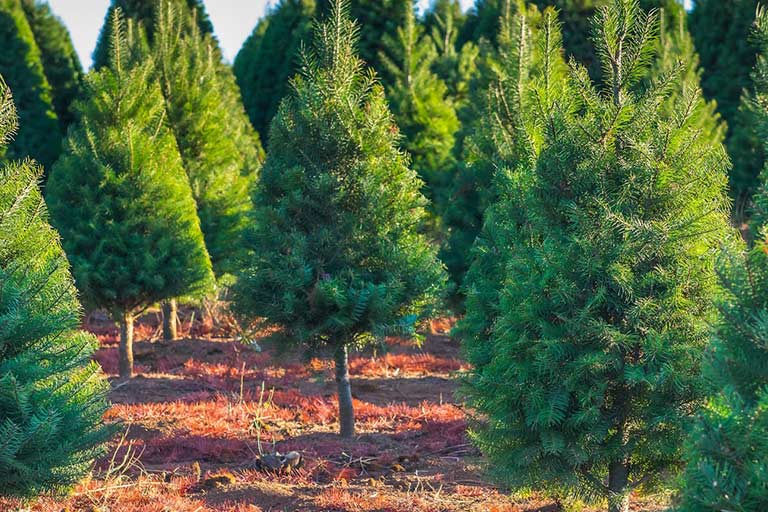Evergreen trees not only enhance your landscape with year-round beauty, but they also play a crucial role in improving air quality. Broad-leaved evergreens like Quercus salicina effectively remove ultra-fine PM2.5 from the air, improving urban air quality and climate warming mitigation (Jin et al., 2021).
However, ensuring your newly purchased evergreen thrives requires proper care from the start. We’ll walk you through essential tips to nurture your tree and keep it growing healthy for years to come.
Selecting the Right Planting Location
Choosing the right location for your newly purchased evergreen tree is crucial to its long-term health and growth. Evergreen trees need an environment that supports their unique requirements, from adequate sunlight to protection from harsh winds.
- Sunlight Requirements
Most evergreen trees thrive in full sunlight, which means at least 6 hours of direct sunlight each day. Consider the tree’s species and check if it can tolerate partial shade, but generally, placing it in a sunny spot ensures vigorous growth and healthy foliage. - Wind Exposure
Strong winds can stress young evergreens and lead to moisture loss through their needles. When selecting a location, try to find an area that offers some natural windbreaks, such as nearby structures or other trees, to reduce wind damage. - Distance from Structures and Other Trees
Ensure that your evergreen has enough room to grow. Plant it far enough from buildings, fences, and other trees to accommodate its mature size. Consider the tree’s width and height once fully grown, and avoid placing it too close to power lines or underground utilities. Proper spacing allows good air circulation, which helps prevent disease. - Soil Conditions and Drainage
The location’s soil should be well-draining and suitable for your evergreen’s root system. Avoid low-lying areas where water tends to accumulate, as evergreens do not thrive in soggy soil. If necessary, make adjustments by improving drainage or selecting a raised planting area.
Preparing the Soil for Evergreen Trees

Healthy soil is the foundation for a thriving evergreen tree. Before planting, it’s crucial to assess and prepare the soil to create an ideal growing environment.
- Soil Drainage
Evergreen trees need well-draining soil to avoid root rot. Test the drainage by digging a small hole and filling it with water. If the water drains within a few hours, the soil is suitable. For areas with poor drainage, consider planting in raised beds or amending the soil with organic material like compost. - Soil pH
Most evergreens prefer slightly acidic soil with a pH level between 5.5 and 6.5. You can test the soil’s pH with a simple test kit from your local garden centre. If adjustments are needed, add sulphur to lower the pH or lime to raise it, depending on the current acidity. - Adding Organic Matter
Incorporating organic matter such as compost, aged manure, or leaf mold into the planting area improves soil structure and nutrient availability. This ensures the roots have access to essential nutrients while maintaining adequate moisture retention. - Mulching
Once the tree is planted, apply a layer of organic mulch around the base. Mulching helps retain moisture, regulate soil temperature, and prevent weed competition. Use materials like wood chips or shredded bark, and spread them in a 2-3 inch layer, ensuring the mulch doesn’t touch the trunk.
Proper Planting Techniques
To ensure your newly purchased evergreen tree thrives, keep these essential tips in mind:
- Choose the Right Hole Size: Dig a hole that is twice as wide as the root ball to encourage root expansion while keeping it slightly shallower than the tree’s height.
- Handle Roots with Care: To avoid constriction and promote outward development, carefully remove the tree from its container and untie any firmly tied roots.
- Align the Tree Properly: Ensure the root flare is level with or slightly above the soil surface to promote healthy growth and stability.
- Backfill Gently: Use the original soil to backfill, packing it lightly around the root ball to eliminate air pockets while avoiding excessive compaction.
- Water Thoroughly: To assist settle the soil and lessen transplant shock, deeply water the tree soon after planting.
Watering Guidelines for New Evergreen Trees
Proper watering is crucial for the successful establishment of your newly planted evergreen tree. Here are some key guidelines to ensure your tree receives the right amount of moisture:
- Initial Watering: After planting, give the tree a thorough soaking. This helps to settle the soil and eliminate any air pockets around the roots, which is vital for reducing transplant shock.
- Establish a Watering Schedule: For the first few months, water your evergreen tree regularly. Aim for deep watering once a week, depending on rainfall. The goal is to keep the soil consistently moist but not soggy.
- Check Soil Moisture: Use your finger or a soil moisture meter to check the moisture level about 2-3 inches below the surface. If the soil feels dry at this depth, it’s time to water.
- Adjust for Weather Conditions: During hot, dry spells, your tree may require more frequent watering. Conversely, reduce watering if you experience heavy rainfall to prevent waterlogged soil.
- Avoid Overwatering: While it’s essential to keep the soil moist, be cautious not to overwater. Signs of overwatering include yellowing needles and root rot. Ensure good drainage to help prevent these issues.
- Watering Techniques: When watering, aim for the base of the tree rather than spraying water on the foliage. This encourages deeper root growth and helps the tree establish itself more effectively.
If you’re considering expanding your landscape with additional evergreens, keep an eye out for trees for sale in Stouffville for a variety of options that can complement your existing greenery.
Pruning and Shaping Your Evergreen

Regular pruning and shaping are vital for the healthy growth and aesthetic appeal of your evergreen tree. Proper techniques not only enhance the tree’s structure but also promote air circulation and light penetration, which are crucial for overall health.
- When to Prune
The best time to prune evergreens is during late winter or early spring before new growth begins. This timing allows you to see the tree’s structure clearly while minimizing stress on the tree. Avoid heavy pruning in late summer or fall, as this can stimulate new growth that may not harden off before winter. - Why Pruning is Essential
Pruning is crucial for removing dead or damaged branches, which can harbour pests and diseases. It also encourages healthy growth by directing energy towards strong, new growth. Proper pruning can prevent issues like overcrowding, ensuring that each branch has enough space to thrive. - Techniques for Shaping
Use clean, sharp pruning shears or saws to make clean cuts. When removing a branch, make the cut at a slight angle just above a bud or lateral branch to encourage new growth.
For shaping, focus on thinning out dense areas to improve air circulation and light access. Remove any crossing or rubbing branches to maintain a balanced structure.
- Consider Seasonal Changes
Be mindful of how seasonal changes can impact your tree. For instance, heavy snow can cause branches to droop, necessitating post-winter adjustments. Regular inspections after storms will help you identify and address any structural issues.
Protecting Your Evergreen Tree from Pests and Diseases
Safeguarding your evergreen tree from pests and diseases is essential for its long-term health. Here are some practical tips to help you identify early signs and take preventive measures:
- Regular Inspections
Conduct routine checks of your tree’s foliage and branches. Look for discoloured or drooping needles, webbing, or holes in the bark. Early detection is vital to managing any issues. - Identify Pests
Familiarize yourself with common pests like aphids, spider mites, and bark beetles. Check for clusters of tiny insects or fine webbing on the foliage. Knowing what to look for helps you respond promptly. - Watch for Diseases
Be aware of signs of fungal infections such as needle blight, which may present as browning needles. Monitor your tree for wilting or unusual growth patterns that could indicate root rot. - Use Eco-Friendly Treatments
Consider natural pest control methods. Neem oil can deter various pests without harming beneficial insects. Insecticidal soap is effective against aphids, and copper-based fungicides can help manage fungal infections. - Encourage Beneficial Insects
Promote a healthy ecosystem by planting flowers that attract beneficial insects like ladybugs and lacewings, which prey on pests.
Cultivate a Lush Landscape Today!
With the right care and attention, your evergreen tree can thrive and beautify your outdoor space for years to come. Whether you’re a seasoned gardener or a newcomer to tree care, following these tips will ensure your tree remains healthy and vibrant.
If you’re looking to add more greenery to your landscape, consider checking out the evergreen trees for sale in Toronto at Caledon Treeland. For expert advice and quality selections, contact us at (905) 880-1828 today!

